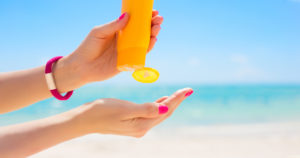
We’ve come a long way since the days of slathering on greasy veterinary-grade petrolatum, the main ingredient in the first sunscreen. Yet in the 75 years since World War II pilot Benjamin Green invented his rudimentary protection against ultraviolet (UV) rays, sunscreen hasn’t always evolved for the better. Today, countless products have flooded the market, all with varying claims for affecting your health.
It’s not just that you need to be wary of the side effects of rogue chemicals and compounds. If the sunscreen you’re using can’t do its job, it’s putting you at risk for sun damage. More than 3 million Americans develop skin cancer every year, making it the most common cancer in the United States. If you want to help reduce your risk, it helps to know the truth behind sun protection. Here are the facts about five common myths to help you choose how to reduce your risk.
Myth: A sunburn is the only sign of skin damage.
The truth: The sun sends out two kinds of rays: short-wave ultraviolet B (UVB) and long-wave ultraviolet A (UVA). UVB rays are responsible for ruining many a summer day with a sunburn. That’s why many sunscreens focused on UVB rays, but that leaves UVA rays free to penetrate the skin and put us at higher risk for developing cancer.
UVA rays go deeper than UVB light, often causing long-term damage, including wrinkles, and potentially triggering changes on a cellular level that may lead to cancer. When you’re shopping for sunscreen, look for one that’s specifically labeled for broad-spectrum protection against UVA and UVB rays. A good rule of thumb is to look for the following ingredients: avobenzone, ecamsule, oxybenzone, titanium dioxide, and zinc oxide. If you are unsure if your sunscreen is blocking harmful rays, check with a doctor.
Myth: Sunscreen and sunblock mean the same thing.
The truth: In practice, sunscreen and sunblock mean exactly what they say they do. Sunscreen has chemicals that permeate the skin and absorb harmful UV rays before they damage the dermal layer. Sunblock, which is a physical or mineral block, has active mineral ingredients such as titanium dioxide or zinc oxide that create a layer on top of the skin to deflect harmful UV rays before they hit the body. Both are designed to protect you from the sun as long as they guard against UVA and UVB rays. Consult a doctor to determine how and when to use sunscreen for your skin type and lifestyle.
Myth: Double the SPF, double the protection.
The truth: SPF, which stands for sun protection factor, only measures how well a sunscreen protects against UVB rays. There is no standard measure for UVA protection, which is why it’s so important to look for broad-spectrum coverage. Within SPF, a higher number is only providing you marginally better coverage than a lower one. A sunscreen with 15 SPF, for example, will protect your skin 15 times longer than it takes your unprotected skin to begin turning red. So choose the SPF according to how sensitive your skin is to the sun, and how long you plan to be outside.
Myth: A light tan is not harmful.
The truth: It’s tempting to go light on SPF in an effort to get a “glow,” or at least proof that you were on vacation. But can you tan safely without risking cancer? “The answer is no,” says Stephen Lynch, MD, Vice Chief of Staff and Primary Care/Intake Physician at our Phoenix hospital. “If you’re exposed to the sun, there is potential for damage.” To help keep yourself protected, reapply sunscreen every two hours regardless of the SPF. You can always share pictures of the beach day to make your coworkers jealous.
Myth: You can use the same bottle of sunscreen until it runs out.
The truth: You can keep using the same bottle, but there’s a limit to its usefulness. The shelf life for your standard drugstore bottle of sunscreen is three years—the amount of time the product is engineered to remain at its original strength. After that, it’s time to toss it. To get the protection advertised, throw away sunscreen that’s surpassed its expiration date. If your sunscreen doesn’t have a printed expiration date, write the date you purchased it on the bottle and be sure to toss it at the three-year mark.
Yes, you have lots of options, colors, scents, and styles of sunscreen. But at the end of the day, it’s important to find one designed to protect your skin. You don’t have to make the decision alone.
Content provided by Cancer Treatment Centers of America. займы на карту
займ на карту оформить займ на карту сбербанказайм под низкий процентзайм до зарплаты онлайн займ денег у частных лиц без залогаденьги в займ под распискузайм на билайн лайм займ личный кабинетекапуста займ личный кабинетманго займ


